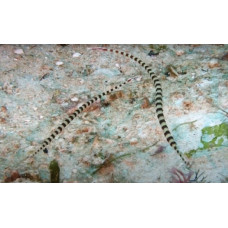Syngnathidae, needlefish or seahorses are a family of fishes of the order Gasterosteiformes. The body is needle-shaped, covered with bony plates. The snout is tubular. The pelvic fins are absent. Dorsal fin without barbed rays. Gills are arranged in bundles. Pectoral, anal and caudal fins are sometimes absent. Marine, coastal, less often pelagic small fish of tropical and temperate waters, some enter the voids of rivers. They live in the coastal zone, among corals, thickets of sea grass, algae. The eggs are hatched in the brood chamber on the underside of the body or tail section of the male. Feed on small planktonic organisms. Planktonophagous and predatory.
The family includes 298 species of fishes grouped in 57 genera. Of these, about 244 species belonging to 56 genera belong to the needlefish and about 54 species belonging to the single genus Hippocampus. Amphelikturus dendriticus from the Bahamas is sort of intermediate between the needlefish and seahorses.
Adult fish sizes range from 2.5 to 60 cm (needlefish) and 4-20 cm (seahorses). Representatives of the family are characterized by a very elongated elongated body (needlefish) or a body shape resembling a chess piece of a horse, with the head inclined to the body and folding mainly tail (seahorses). The head has a tube-shaped snout. The tail is long and can be used to attach to algae and various objects.
Coloration is very variable: red, purple, yellow, brown, green, gray with various spots, white. A number of species are able to change the coloration of the body depending on the background of the environment. Many species have developed mimicry: body shape, coloration, rocking movements imitate the surrounding algae or corals.
The family includes marine and brackish-water fishes, as well as a small number of freshwater species. They are distributed in the coastal zone of tropical and temperate waters. Prefer to settle near sandy shores, in thickets of algae and coral. There are species that live permanently in the water column, such as pelagic Syngnathus schmidti found in the Black Sea and Entelurus aequoreus from the Sargasso Sea, found in the open Atlantic Ocean. In Russia there are 2 genera of sea needles (Neropkis, Syngnathus) and 1 genus of seahorses (Hippocampus). In the basins of the Black Sea and the Sea of Azov there is a sea needle 18-21.5 cm long (S. nigrolineatus), which enters rivers, and in the Sea of Japan there is a seahorse (N. japonicus).
Sea needles and skates feed mainly on small planktonic crustaceans. The tubular snout acts like a pipette: when the cheeks are abruptly inflated, the prey is quickly drawn into the mouth from a distance of up to 4 cm. Noticing a small crayfish, the seahorse looks at it for a second or two and then, turning its snout to a comfortable position, suddenly pulls in the crayfish and swallows it. Young seahorses are able to feed for 10 hours a day and during this time they eat up to 3,600 small Artemia salina (Artemia salina).
The breeding process is complex. The male always takes care of the offspring. In most species, it is the male who carries the eggs in a special "brood pouch" - a closed chamber located on the underside of the body in the tail section. The female lays eggs in the pouch in small portions. In the process of laying the eggs are fertilized. In eagle fish brood pouch long, longitudinal, with a central longitudinal slit and two lateral flaps, which in many species during the period of incubation of eggs can be completely closed, isolating the developing embryos from the external environment. In seahorses, the pouch is organized differently. It is always under the tail and closed; there is only a small opening in the front of the bag for laying eggs through it and for the exit of fry when they are hatched from the eggs. With the onset of the breeding season, this pouch thickens and is permeated with blood vessels; in this way it is prepared to receive the eggs and nourish the embryos.
Syngnathidae
Tags: syngnathidae



